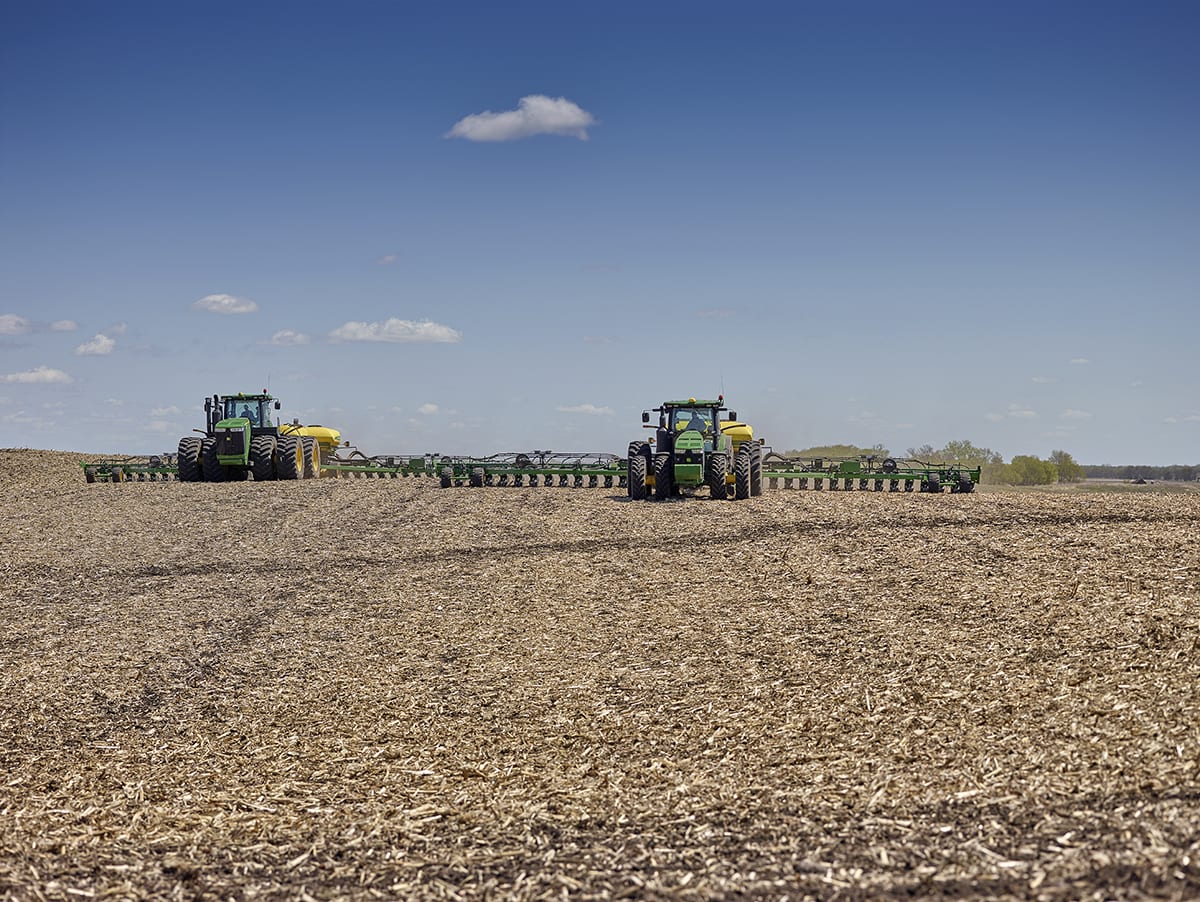We started planting both soybeans and corn the last week of April, even though we had snow the weekend before in some of our fields. We started in fields where we didn’t have any accumulation of snow. And once we start, we push to get our crops planted as quickly as possible.
 It takes 20 to 25 days of good weather and minimal equipment problems to plant our 9,700 hectares, or 24,000 acres, of soybeans and corn. We rely on a combination of large equipment and man hours to get it done.
It takes 20 to 25 days of good weather and minimal equipment problems to plant our 9,700 hectares, or 24,000 acres, of soybeans and corn. We rely on a combination of large equipment and man hours to get it done.
Right now, we have two vertical tillage disks cutting up the residue in last year’s corn fields. Many of those fields will be planted to soybeans this year. For fields that will be planted to corn this spring, two field cultivators are incorporating the dry fertilizer that was spread into last year’s soybean residue to ensure it is available to the crop.
We have three planters running behind the tillage equipment. Right now, two are planting soybeans, and one is planting corn.
After a soybean field is planted, we roll the field. This pushes the rocks in our soil down and flattens the field to allow easier, cleaner harvest. The rocks are less likely to damage harvest equipment in rolled fields.
 At the beginning of May, we also started applying residual herbicides in the planted soybean and corn fields to control weeds. These herbicides are sprayed before the crops emerge from the ground. We vary the herbicides we use based on the crop and field conditions. We always apply herbicides in corn. However, some soybean fields don’t need an herbicide application because tillage and rolling has effectively controlled early season weeds.
At the beginning of May, we also started applying residual herbicides in the planted soybean and corn fields to control weeds. These herbicides are sprayed before the crops emerge from the ground. We vary the herbicides we use based on the crop and field conditions. We always apply herbicides in corn. However, some soybean fields don’t need an herbicide application because tillage and rolling has effectively controlled early season weeds.
We also vary herbicides and application timing based on the weather forecast. Although we spray herbicides when it is dry and calm, rain activates the chemistry that effectively prevents weeds from germinating or growing.
We’ve had really nice weather for planting. We plant soybeans nearly 4 cm, or 1.5 inches, deep, and we plant corn 5 cm, or 2 inches deep. Though we could use some rain to activate herbicides, our soils have plenty of moisture where the seeds are planted, thanks to the abundance of rain we’ve gotten the last couple years.
 I am running one of the soybean planters, but in a few days, I will switch to corn. In the heart of planting, I will spend between 14 and 18 hours in the tractor. These are long days. Working together, our team can plant between 405 and 485 hectares, or 1,000 to 1,200 acres, each day.
I am running one of the soybean planters, but in a few days, I will switch to corn. In the heart of planting, I will spend between 14 and 18 hours in the tractor. These are long days. Working together, our team can plant between 405 and 485 hectares, or 1,000 to 1,200 acres, each day.
I switch as needed between crops I plant depending on field conditions and how we want to spread out harvest this coming fall. Harvest takes longer than planting, and we plan now to attempt to have fields ready to harvest at different times to protect crop quality. Planting timing and soybean maturity group helps us do this. We plant soybeans with maturities between .9 and 1.5, which are short season soybeans that perform well in our short growing season. When planting goes late, we will plant .3 maturity group soybeans so they fill soybeans before our first average frost date, around Sept. 20.
Our large equipment is one example of the technology that helps us farm. We also take advantage of variable rate technology this time of year. We vary fertilizer rates and corn seeding rates based on soil type.
Because soybeans adapt more easily to field conditions, we use the same seeding rate for all our soybean fields.
We got an earlier start on planting than last year. And we are not fighting to plant wet fields, like we have the past two years. So though the days are long, our 2021 growing season is off to a really good start.

